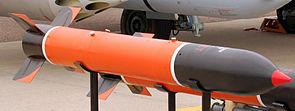S-24 (missile)
| S-24 (missile) | |
|---|---|
| General Information | |
| Type | Air-to-surface missile |
| Local name | S-24, C-24, ADR-240 |
| NATO designation | S-24 |
| Country of origin |
|
| Manufacturer | OKB-16 (Nudelman design office) |
| development | 1950s |
| Commissioning | 1960 |
| Working time | in service |
| Technical specifications | |
| length | 2.22 m |
| diameter | 240 mm |
| Combat weight | 235 kg |
| span | 600 mm |
| drive | Solid rocket engine |
| speed | about Mach 1.2 |
| Range | 2-3 km |
| Furnishing | |
| steering | no |
| Target location | no |
| Warhead | 123 kg fragmentation warhead |
| Detonator | Impact detonator or proximity detonator |
| Weapon platforms | Airplanes, helicopters |
| Lists on the subject | |
The S-24 is an unguided air-to-surface missile that was developed in the Soviet Union and is still used by the Russian Air Force.
development
In the mid-1950s, the OKB-16 ( Nudelman design office ) received an order to develop a successor to the problematic S-21 air-to-surface missile . In 1958, the first attempts at shooting were made with the MiG-21 and Su-7 aircraft. The S-24 was introduced to the Air Force of the Soviet Union in late 1960 .
technology
The S-24 rocket with a caliber of 240 mm is spin stabilized and has four stabilizing wings at the rear. The rocket's twist is created by six diagonally arranged nozzles at the rear. These generate a twist of 470 revolutions per minute. The rocket consists of a steel tube. In the front part of the tube is the warhead , in the rear part the solid rocket engine . This has a burn time of around 1.1 seconds and accelerates the rocket to over Mach 1.2. The course deviation is 0.3–0.4%, which corresponds to 6–8 m over a combat distance of 2 km.
The fragmentation warhead of the S-24 version weighs 123 kg, of which 23.5 kg is accounted for by the explosives . Upon impact, the warhead splits into 4,000 fragments with an effective radius of 300 to 400 m. In the embodiments S-24N of the fragmentation warhead is the RV-24 - proximity fuze about 30 m above the ground brought to detonation and so achieve its optimum fragmentation effect. The S-24B version is equipped with a hardened warhead to combat bunkered targets. The V-575 delay detonator can be adjusted depending on the target characteristics (delay or impact).
Due to its size, the S-24 is not launched from multiple launch containers like other unguided air-to-surface missiles. The S-24 is attached to the aircraft's weapons pylon by means of a rocket launch rail. Initially, the PU-12-40U starter rail was used. The APU-7D starting rail was added in the 1980s . The S-24 missiles can also be used from the APU-68U universal launch rail .
Versions
- S-24: Standard variant with fragmentation warhead
- S-24N: Version with fragmentation warhead with proximity fuse
- S-24B: Version with bunkering warhead
- S-24BNK: Version with shaped charge warhead
- S-24L: Prototype with semi-active laser guidance
- S-24SE: Prototype with GLONASS steering system
commitment
S-24 missiles were used in various armed conflicts: in the First Afghanistan War , the First Gulf War , the Yugoslav War , the First Chechnya War , the Caucasus War in 2008 and in conflicts on the African continent .
Platforms
Airplanes:
- Mikoyan-Gurevich MiG-17 Fresco
- Mikoyan-Gurevich MiG-21 Fishbed
- Mikoyan-Gurevich MiG-23 Flogger
- Mikoyan-Gurevich MiG-27 Flogger
- Sukhoi Su-7 Fitter
- Sukhoi Su-17 Fitter
- Sukhoi Su-20 Fitter
- Sukhoi Su-22 Fitter
- Sukhoi Su-24 Fencer
- Sukhoi Su-25 Frogfoot
- Yakovlev Yak-38 Forger
Helicopter:
distribution
The S-24 was introduced in the Soviet Union. The weapon found widespread use in the Warsaw Pact participating states as well as in states in Africa . The S-24 was also procured by several other states that used Soviet fighter jets and helicopters or their Chinese derivatives.
-
 Afghanistan
Afghanistan
-
 Algeria
Algeria
-
 Egypt
Egypt
-
 Bulgaria
Bulgaria
-
 Czech Republic
Czech Republic
-
 India
India
-
 Iraq
Iraq
-
 Kazakhstan
Kazakhstan
-
 Poland
Poland
-
 Romania
Romania
-
 Turkmenistan
Turkmenistan
-
 Hungary
Hungary
-
 Ukraine
Ukraine
-
 Uzbekistan
Uzbekistan
-
 Belarus
Belarus
Individual evidence
- ↑ a b С-24 airwar.ru, accessed on August 28, 2013
- ↑ a b c d Jefim Gordon : Soviet / Russian Aircraft Weapons since World War Two. Midland Publishing, 2004, p. 175.
- ^ A b Duncan Lennox: Jane's Air Launched Weapons Systems Edition 2003. Jane's Information Group .
- ↑ a b Russian Air Force prepares to test guided rockets ( Memento from July 5, 2013 in the Internet Archive ) IHS Jane's 360, accessed on August 28, 2013
- ↑ cat-uxo.com on [1] , accessed on August 21, 2014
